LR12中针对WebServices协议的三种脚本开发模式
一,webservices协议简介
webservices是建立可交互操作的分布式应用程序的新平台,它通过一系列的标准和协议来保证程序之间的动态连接,
其中最基本的协议包括soap,wsdl,uddi.
1,SOAP(simple object access protocl)
SOAP是消息传递协议,它规定了web services之间如何传递消息。SOAP基于xml和xsd,xml是soap的数据编码方式。
2,WSDL(web services Description Language)
WSDL是web services的定义语言,和soap一起构成web服务的核心结构单元。wsdl协议规定了有关webservices描述的标准。
3,UDDI(Universal Description,Discovery,and Intergration)
UDDI是访问登记的标准,它建立了一个平台独立,开放的框架,通过英特网来描述服务,发现业务并整合业务服务。简单来说
UDDI用于集中存放和查找wsdl描述文件,起着目录服务器的作用。
二,我们在性能测试的工作中,难免会遇到webservices协议的接口,这里我简单介绍一下用loadrunner12来开发webservices协议脚本
的三种模式,咱们就以天气预报的网站来为例吧:
1,web_service_call模式
1)启动“virtual user Generator”,新建“web services”虚拟用户,
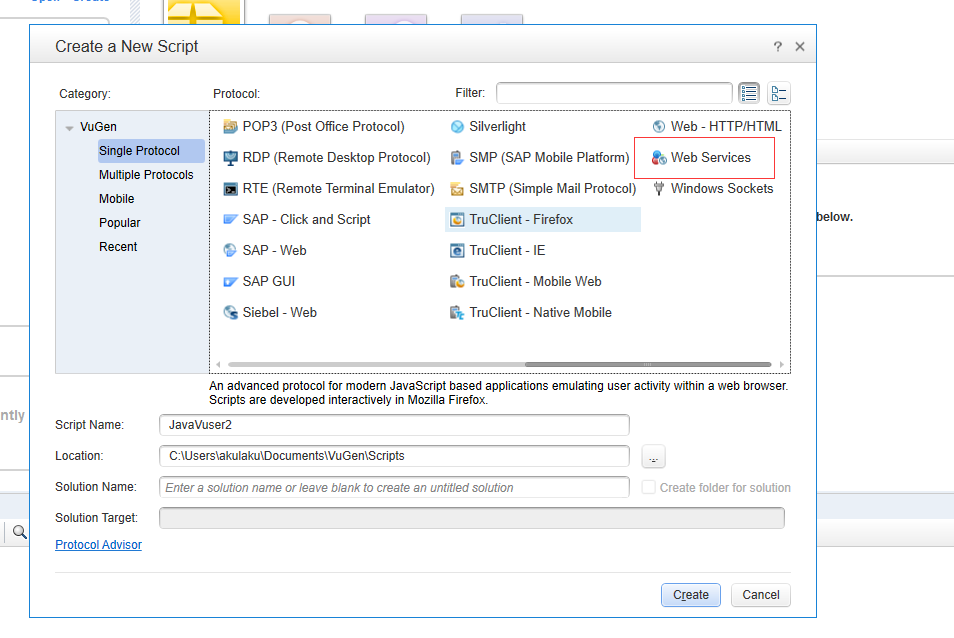
2)选择上方SOA Tool中的Add Service Call,如下图
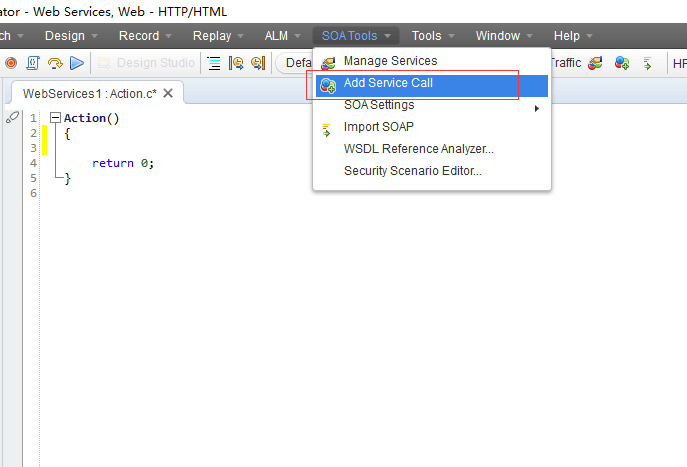
3)弹出New Web Service Call对话框,选择Service-import service

4)输入要测试的网址
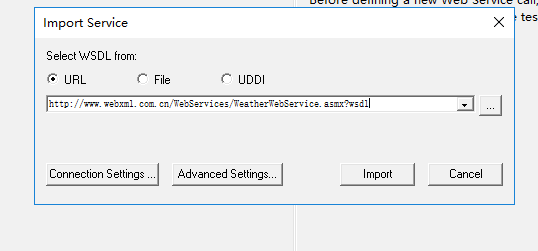
5)下面选择Operation,输入城市,以及设置获取返回值参数
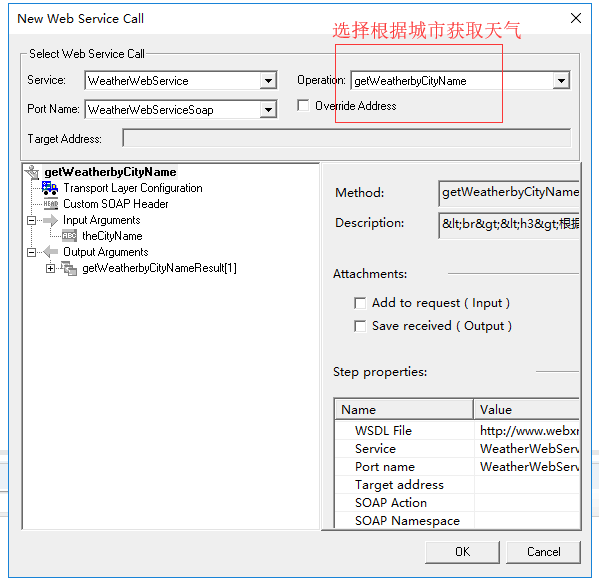


6)点击OK后,得到下面的脚本
Action()
{
web_service_call(
"StepName=getWeatherbyCityName_104", //步骤名称
"SOAPMethod=WeatherWebService|WeatherWebServiceSoap|getWeatherbyCityName", //服务名称|soap获取哪个接口
"ResponseParam=response", //返回的参数信息
"Service=WeatherWebService", //webservices的服务
"ExpectedResponse=SoapResult", //请求返回的信息
"Snapshot=t1555545923.inf", //快照
BEGIN_ARGUMENTS, //输入参数开始
"theCityName=广州", //请求的参数与值
END_ARGUMENTS, //结束参数
BEGIN_RESULT, //返回值的开始
"getWeatherbyCityNameResult/*[1]=Param_string", //保存返回参数
END_RESULT, //返回值结束
LAST);
return 0;
}
6)然后做参数化,断言
Action()
{
lr_start_transaction("获取天气预报");
web_service_call(
"StepName=getWeatherbyCityName_104", //步骤名称
"SOAPMethod=WeatherWebService|WeatherWebServiceSoap|getWeatherbyCityName", //服务名称|soap获取哪个接口
"ResponseParam=response", //返回的参数信息
"Service=WeatherWebService", //webservices的服务
"ExpectedResponse=SoapResult", //请求返回的信息
"Snapshot=t1555545923.inf", //快照
BEGIN_ARGUMENTS, //输入参数开始
"theCityName={city_name}", //请求的参数与值
END_ARGUMENTS, //结束参数
BEGIN_RESULT, //返回值的开始
"getWeatherbyCityNameResult/*[2]=Param_string", //保存返回参数
END_RESULT, //返回值结束
LAST);
if(strcmp(lr_eval_string("{Param_string}"),lr_eval_string("{city_name}"))==0)
{
lr_end_transaction("获取天气预报",LR_PASS);
}
else
{
lr_end_transaction("获取天气预报",LR_FAIL);
}
return 0;
}
7)最后保存,设置日志级别,然后Replay我们的脚本

2,soap_request模式
1)打开WeatherWebService网站,

2)复制上面的代码,在notepad++中新建一个文件,将代码粘贴上去,保存到D盘,然后在loadrunner12中
点击下图的import SOAP


3)在对话框中,我们输入保存的xml文件地址,输入URL,URL=http://{Host}+{POST} 参数从
上图所示取,输入对应的SOAPAction,具体如下图所示
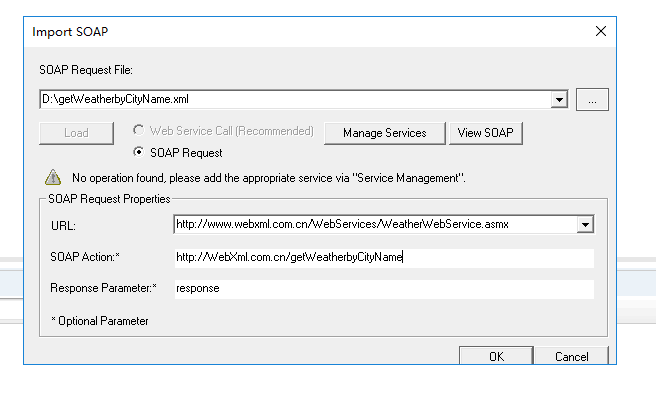
4)点击OK,生成下面的脚本
Action()
{
soap_request("StepName=SOAP Request",
"URL=http://www.webxml.com.cn/WebServices/WeatherWebService.asmx",
"SOAPEnvelope="
"<soap:Envelope xmlns:xsi=\"http://www.w3.org/2001/XMLSchema-instance\" xmlns:xsd=\"http://www.w3.org/2001/XMLSchema\" xmlns:soap=\"http://schemas.xmlsoap.org/soap/envelope/\">"
"<soap:Body>"
"<getWeatherbyCityName xmlns=\"http://WebXml.com.cn/\">"
"<theCityName>广州</theCityName>"
"</getWeatherbyCityName>"
"</soap:Body>"
"</soap:Envelope>",
"SOAPAction=http://WebXml.com.cn/getWeatherbyCityName",
"ResponseParam=response",
"Snapshot=t1555549382.inf",
LAST);
return 0;
}
5)这里有个难题就是如何做xml断言?我们看一下下图的响应示例
HTTP/1.1 200 OK
Content-Type: application/soap+xml; charset=utf-8
Content-Length: length
<?xml version="1.0" encoding="utf-8"?>
<soap12:Envelope xmlns:xsi="http://www.w3.org/2001/XMLSchema-instance" xmlns:xsd="http://www.w3.org/2001/XMLSchema" xmlns:soap12="http://www.w3.org/2003/05/soap-envelope">
<soap12:Body>
<getWeatherbyCityNameResponse xmlns="http://WebXml.com.cn/">
<getWeatherbyCityNameResult>
<string>string</string>
<string>string</string>
</getWeatherbyCityNameResult>
</getWeatherbyCityNameResponse>
</soap12:Body>
</soap12:Envelope>
这里引入lr_xml_get_values函数来获取xml的返回值
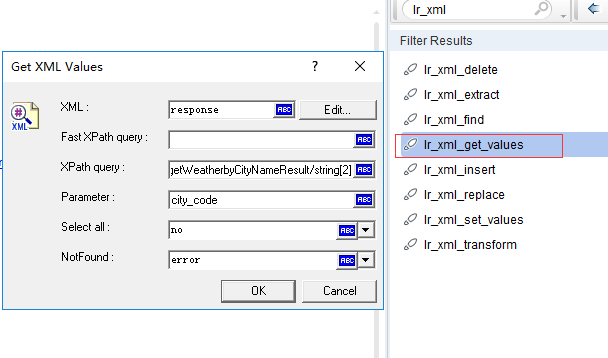
XPath query中填入city值的xpath定位的绝对路径:/Envelope/Body/getWeatherbyCityNameResponse/getWeatherbyCityNameResult/string[2]
6)最后加入事物函数,做断言
Action()
{
lr_convert_string_encoding(lr_eval_string("{city_name}"),NULL,"utf-8","city");
lr_save_string(lr_eval_string("{city}"),"cityName");
lr_start_transaction("获取天气预报");
soap_request("StepName=SOAP Request",
"URL=http://www.webxml.com.cn/WebServices/WeatherWebService.asmx",
"SOAPEnvelope="
"<soap:Envelope xmlns:xsi=\"http://www.w3.org/2001/XMLSchema-instance\" xmlns:xsd=\"http://www.w3.org/2001/XMLSchema\" xmlns:soap=\"http://schemas.xmlsoap.org/soap/envelope/\">"
"<soap:Body>"
"<getWeatherbyCityName xmlns=\"http://WebXml.com.cn/\">"
"<theCityName>{cityName}</theCityName>"
"</getWeatherbyCityName>"
"</soap:Body>"
"</soap:Envelope>",
"SOAPAction=http://WebXml.com.cn/getWeatherbyCityName",
"ResponseParam=response",
"Snapshot=t1555549382.inf",
LAST);
lr_convert_string_encoding(lr_eval_string("{response}"),"utf-8",NULL,"msg");
lr_xml_get_values(
"XML={response}",
"Query=/Envelope/Body/getWeatherbyCityNameResponse/getWeatherbyCityNameResult/string[2]",
"ValueParam=city_code",
LAST);
lr_output_message("返回城市名称:%s",lr_eval_string("city_code"));
if(strcmp(lr_eval_string("{city_code}"),lr_eval_string("{city_name}"))==0)
{
lr_end_transaction("获取天气预报", LR_PASS);
}
else
{
lr_end_transaction("获取天气预报", LR_FAIL);
}
return 0;
}
7)保存后点击Replay,得到下面的结果:

3,web_custom_request模式
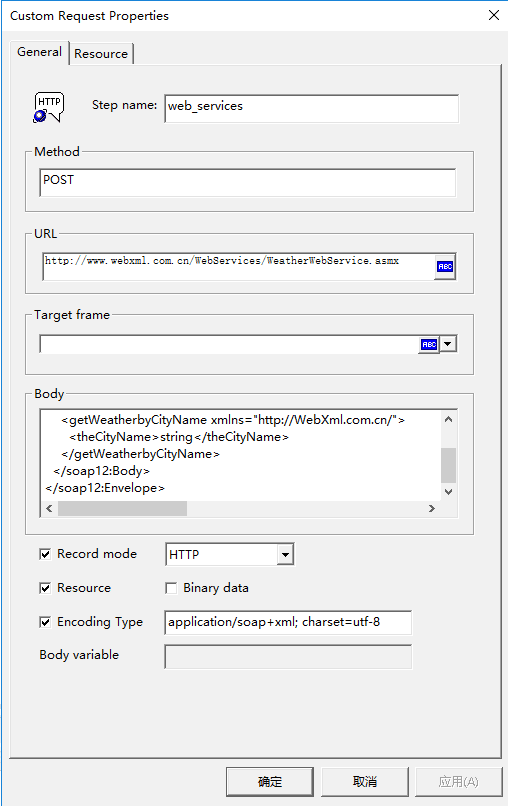
输入对应的URL,body里面输入SOAP的请求体,点击确定,最后生成如下的代码
Action()
{
web_custom_request("web_services",
"URL=http://www.webxml.com.cn/WebServices/WeatherWebService.asmx",
"Method=POST",
"TargetFrame=",
"Resource=1",
"Referer=",
"Mode=HTTP",
"EncType=application/soap+xml; charset=utf-8",
"Body=<?xml version=\"1.0\" encoding=\"utf-8\"?>"
"<soap12:Envelope xmlns:xsi=\"http://www.w3.org/2001/XMLSchema-instance\" xmlns:xsd=\"http://www.w3.org/2001/XMLSchema\" xmlns:soap12=\"http://www.w3.org/2003/05/soap-envelope\">"
"<soap12:Body>"
"<getWeatherbyCityName xmlns=\"http://WebXml.com.cn/\">"
"<theCityName>59287</theCityName>"
"</getWeatherbyCityName>"
"</soap12:Body>"
"</soap12:Envelope>",
LAST);
return 0;
}
后面做脚本强化就行了。


